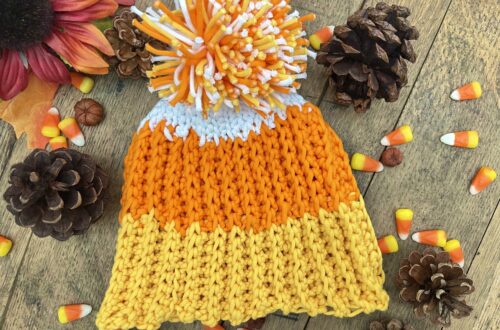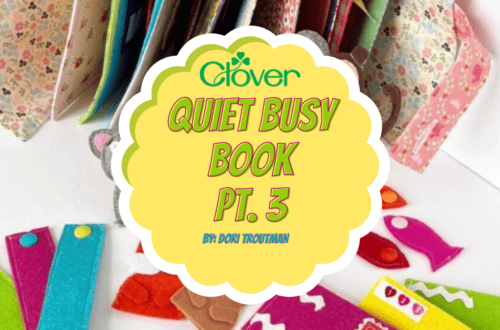Fabric Tool Roll – Sewing Project

Hi there, Erin from CraftsEverywhere here! Today I’m bringing you a tutorial for a fabric tool organizer, a great beginner sewing project that is perfect for organizing your knit, crochet and craft supplies.
I designed these little organizers when I got more knitting needles than I knew what to do with and needed some way to organize them. This pattern can be adapted for any size needles, hooks or craft supplies. You can measure your tools so you can make pockets specifically for them or divide the space evenly. It’s super easy to customize! Let’s get started!
Skill Level
Beginner
Materials
- 2 fat quarters – Approximate measurements 17.5″ x 21.5″ and 11″ x 21.5″
- Interfacing – Approximate measurements 5.5″ x 21.5″
- Fastener
- Hair Elastic and button, or
- Ribbon, two 18″ pieces, or
- Leather strip, 18″
- Quilting Pins – (Art No. 2508)
- Ruler or Fabric Mat
- Sewing Machine
- Patchwork Scissors – (Art No. 493)
- Wax Paper
- Pencil
Notes
This tutorial can be adapted for any size. I have used two full-size fat quarters and a taller pocket for DPNs and also made it slightly smaller for a small set of needles too.
Finished Dimensions
Approximately 17″ x 20″
Step One
Cut out all pieces of fabric and interfacing to dimensions. Your width dimension should be based off of the largest fabric piece which you are using for the outside (21.5″ in the tutorial). All fabric quarters vary a little bit in length and width so the dimensions provided in this tutorial are a general rule of thumb only.
You will need:
- Main Fabric – 17.5″ x 21.5″
- Inside Pocket Fabric – 11″ x 21.5″
- Interfacing – 5.5″ x 21.5″
Step Two
Assemble your pieces for sewing.
- Lay interfacing down on table.
- Place the main fabric with the right side facing you and the wrong side on the interfacing, line the bottom edge up with the interfacing.
- Fold pocket fabric double with the right sides out and the open side towards the bottom. Line up the edges again so all are even. From bottom to top, the order will be: Interfacing, Main fabric (right side up), Pocket fabric (folded in half with the right sides out, open edge on the bottom).

- Add your fastener (hair elastic, two pieces of ribbon with right sides together, or a strip of leather) near the top of the pocket fabric.


- Fold the main fabric in half and match the top edge to the bottom edge.
- Pin all layers together. Add pins on either side of the elastic or leather strip if you are using those to make sure it stays in place or pin through the ribbons. You will be leaving about a 3″ gap in the bottom where all the edges meet up when sewing so that you can turn it right-side out. I find it easiest to mark the edges of this area with pins so that you leave a large enough opening.

Step Three
Sew all layers together.
- Start on one side by the fold on the main fabric and sew down the side with a 1/2″ inseam.
- Turn to sew across the bottom and use a 5/8″ inseam, making sure to leave your 3″ opening on the bottom somewhere for turning right-side out.
- Sew up the other side using a 1/2″ inseam.
- Trim all seams to 1/4″ except the area around the opening you left. Leave that as is so that you can fold the sides together easier when you topstitch around the whole piece after turning right-side out.

- Turn right-side out using the 3″ opening on the bottom.
Step Four
Iron if desired at this point to help place the pocket seams more evenly. Avoid your fastener so it doesn’t melt.
Cut a piece of wax paper to the same size as the pocket and pin it to the fabric.

Using a ruler, measure out your pockets and mark lightly with a pencil based on the measurements you want or you can also make a handful of 1″ pockets and one bigger pocket with your leftover area.

Leave 1/4″ on each edge for your topstitch border.
Step Five
Sew down each line you made with your pencil very carefully, sewing the wax paper and the fabric together.
Rip off the wax paper after you have sewn each pocket. Trim all thread ends.

Step Six
Pin the main fabric together by the fold to keep the top straight and topstitch around the entire piece with a 1/4″ inseam.
I use a decorative stitch when I topstitch because I’m definitely not a pro at the sewing machine and the decorative stitches help hide mistakes!
Trim your thread ends and you’re finished. Stash all those tools in your new organizer and admire it!

Now that you’ve finished your organizer, make sure to show it off on social media by tagging me using @therearecraftseverywhere on Instagram or Facebook!
If you have any questions regarding the tutorial, don’t hesitate to contact me at erin.oetker@gmail.com or through my messages on Etsy or Instagram.
Erin
Find CraftsEverywhere on social media! Instagram | Facebook | Ravelry | Etsy
Stay connected with Clover on Facebook | Twitter | Instagram | Pinterest | YouTube | Ravelry
[mc4wp_form id=”11289″]


